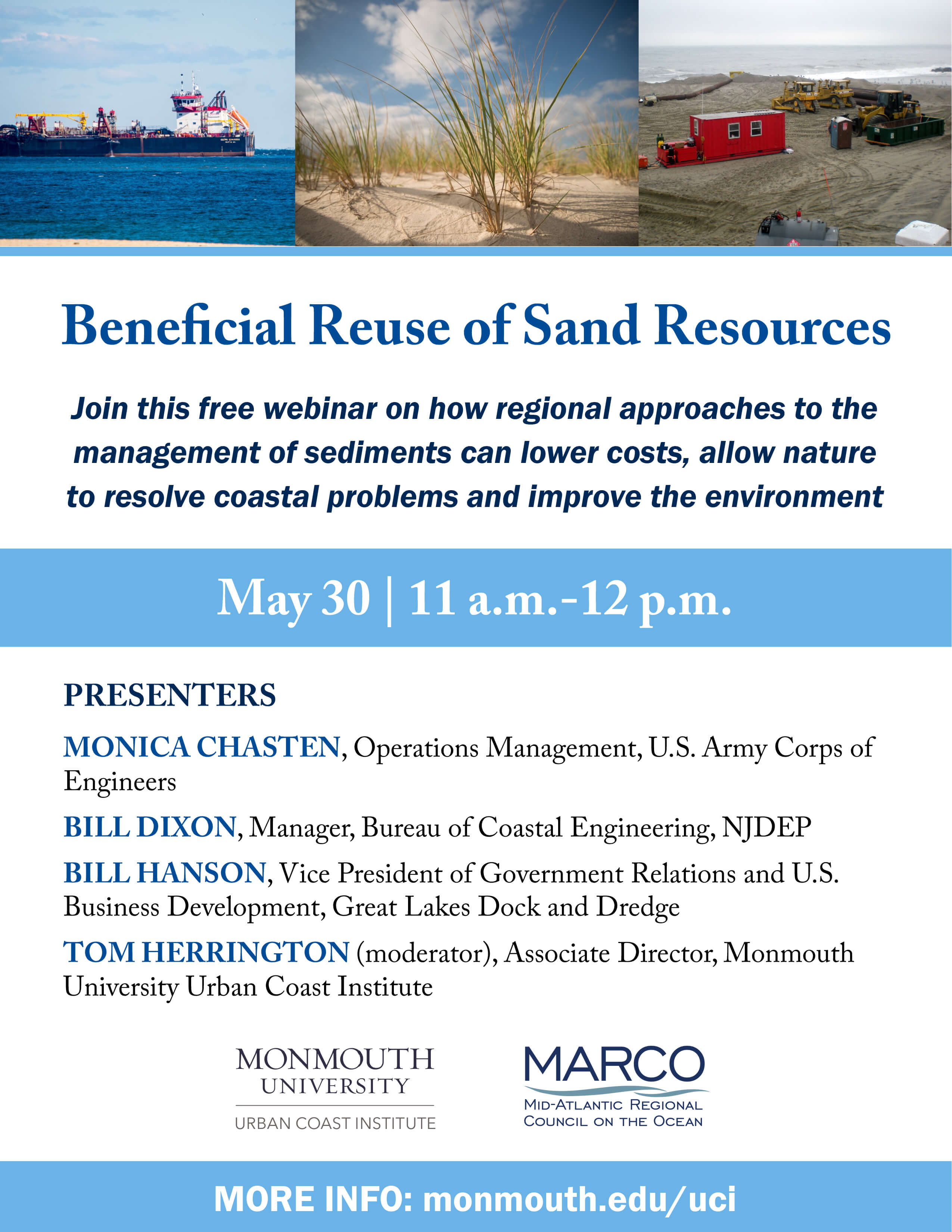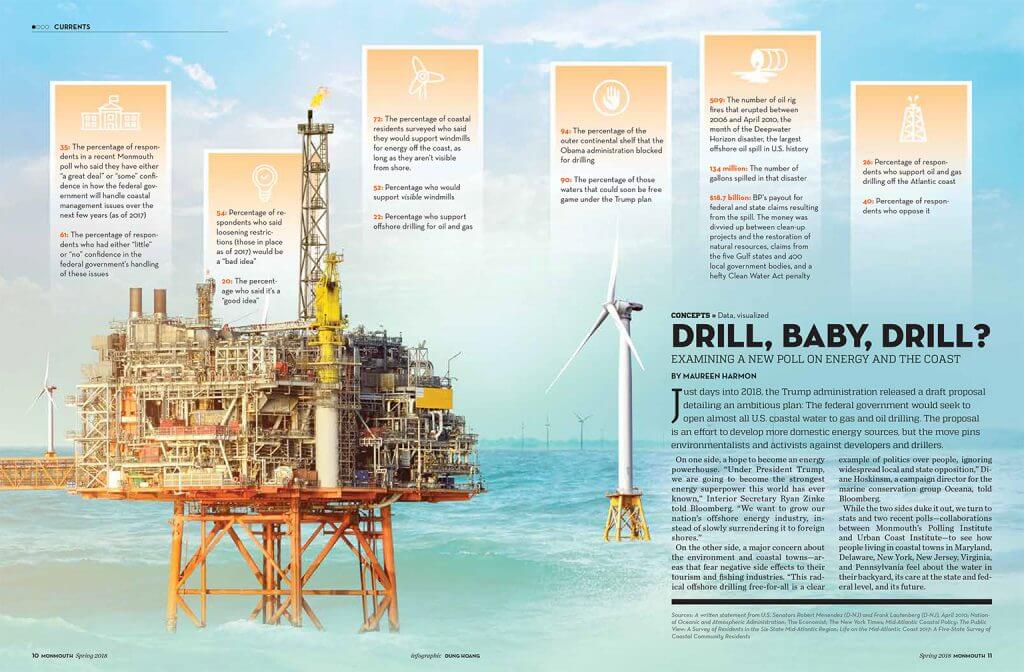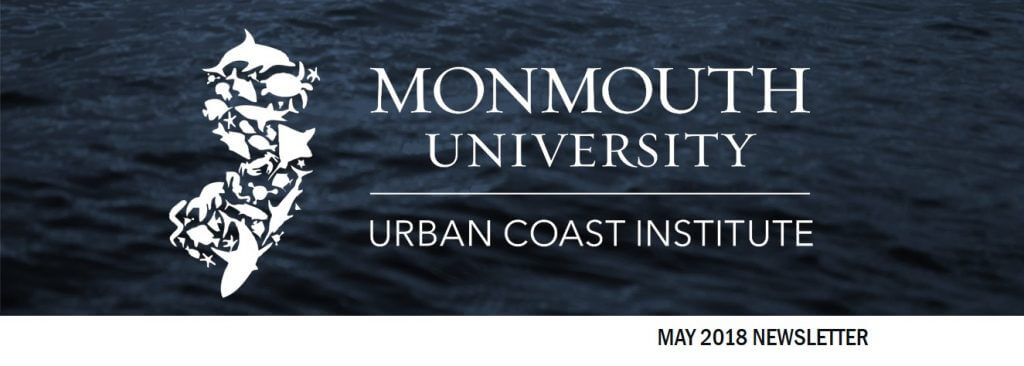
Six Summer Research Projects Receive UCI Support
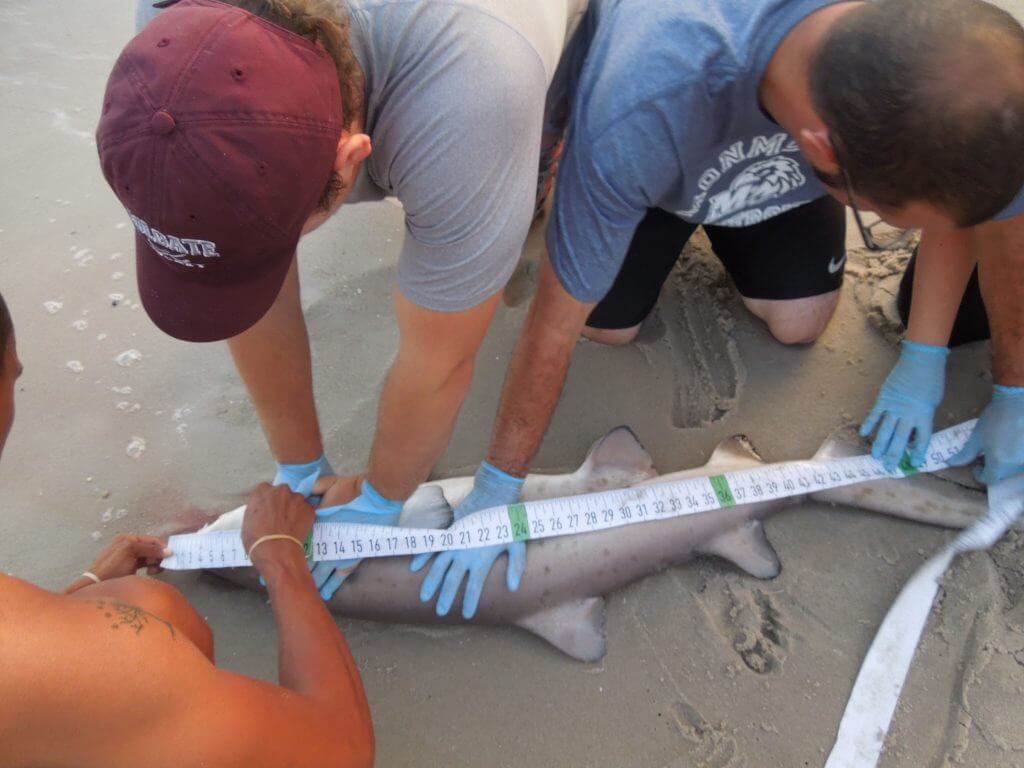
Monmouth University student-faculty research teams will be searching high and low for information about the Jersey Shore’s unique environments this summer with the help of tools ranging from aerial drones to fishing longlines.
Six projects were recently selected to receive funding support through the UCI’s Heidi Lynn Sculthorpe Summer Research Program and Marine Science & Policy Initiative. The work will be completed by 20 students, faculty and staff members representing a wide range of academic disciplines.
The programs emphasize hands-on research projects that provide real world experience for students while helping make a difference in the communities where they take place. The UCI makes competitive grant funding available for students to design and propose their own research ideas and see them through with guidance from Monmouth University faculty mentors, or for faculty to propose projects that employ student researchers. Below are this summer’s grant recipients.
Heidi Lynn Sculthorpe Projects
Discovering the Ecological Self: As part of her thesis research, student Lia Stiles will extend the UCI-supported Discovering the Ecological Self project by interviewing participants and cataloging documents, images, and videos online for public viewing.
Student Researcher: Lia Stiles
Faculty Mentor: Kimberly Callas, Dept. of Art
Exploring Nest-Site Selection in Northern Diamondback Terrapins: The aim of this study is to determine how female terrapins’ nest site selection is influenced by vegetation. Field experiments will be conducted to determine if shifts in vegetative structure caused by climate change pose potential threats to the terrapin nesting process.
Student Researcher: Taylor Donovan
Faculty Mentor: Pedram Daneshgar, Dept. of Biology
The Impact of Environmental Factors on Government Stability in Guatemala: The team will investigate how climate change is contributing to government instability in Guatemala by disturbing traditional farming practices/the economy, and provide insight on the potential political impact of future coastal climate refugees on governments such as the U.S. and Mexico.
Student Researchers: Justin Dritschel and James Hawk
Faculty Mentor: Ken Mitchell, Dept. of Political Science and Sociology
Marine Science and Policy Initiative Projects
Classification and Measurement of Aerial Imagery with TensorFlow: A student-faculty research team will develop techniques and methodologies with TensorFlow software to analyze and classify aerial images taken by a drone. Aerial Applications will contribute image data and project management guidance to the team.
Student Researchers: Steven P. Cassidy, Mahmoud E. Shabana and Nianqi Tian
Faculty Mentors: Gil Eckert, Dept. of Computer Science/Software Engineering; Jim Nickels, UCI marine scientist
Conservation and Demographics of New Jersey Coastal Sharks and Sturgeon: Associate Professor Keith Dunton will continue his research into the demographics and habitats of sturgeon, sharks and rays along the New Jersey coast.
Student Researchers: Lauren Kelly, Troy Ohntrup and Charlie Vasas
Faculty Mentor: Keith Dunton, Dept. of Biology
Harmful Algal Blooms in Monmouth County Coastal Lakes, Estuaries, and Ocean: The researchers will examine the factors contributing to harmful algal blooms in the Navesink and Shrewsbury rivers, Deal Lake, and the nearshore ocean off Monmouth County beaches in order to build a better understanding of their formation and help predict/manage them in the future.
Student Researchers: Erin Conlon, Skyler Post and Katelyn Saldutti
Faculty Mentor: Jason Adolf, Dept. of Biology
These opportunities have been made possible through the generous support of many private and corporate donors. If you would like to make a tax-deductible gift to the Urban Coast Institute, please use our Give a Gift Now contribution form.
Panel Explores Promise of eDNA for Marine Life Research
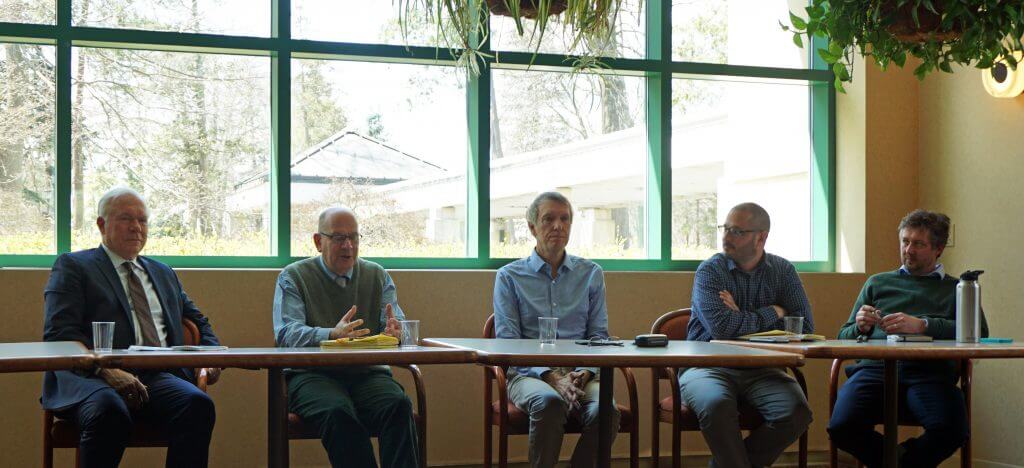
Monmouth and Rockefeller universities are pioneering a marine life detection technique that holds the promise of being less expensive, more humane and more revealing than other longstanding scientific methods. Faculty and students from both institutions have been conducting research in New Jersey and New York coastal water bodies with environmental DNA (eDNA), an approach that allows scientists to confirm the presence of fish and other organisms by testing for trace amounts of genetic material that they shed into the water.
The UCI hosted a panel discussion on April 18 that broke down the science of eDNA and provided an update on next steps for collaboration between the universities. This includes plans to conduct eDNA research in local water bodies such as Sandy Hook Bay, Deal Lake and the Navesink and Shrewsbury rivers this summer.
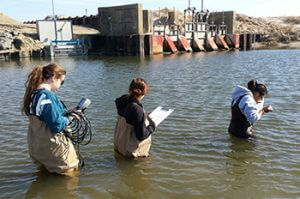 The UCI and Rockefeller University Program for the Human Environment (PHE) are also in the process of organizing a first-ever national conference on marine eDNA, to be held in New York City this fall. It will be the third in a series of joint UCI-PHE symposiums (The Marine Science & Policy Series), following the 2016 National Ocean Exploration Forum and last year’s Mid-Atlantic Blue Ocean Economy 2030 forum.
The UCI and Rockefeller University Program for the Human Environment (PHE) are also in the process of organizing a first-ever national conference on marine eDNA, to be held in New York City this fall. It will be the third in a series of joint UCI-PHE symposiums (The Marine Science & Policy Series), following the 2016 National Ocean Exploration Forum and last year’s Mid-Atlantic Blue Ocean Economy 2030 forum.
During the panel discussion, PHE Director Jesse Ausubel said eDNA testing has proven to be a great method for confirming the presence of organisms, as it can help advance projects that might otherwise depend on detecting rare, endangered or hard to find species through visual means. He said more work needs to be done to understand its capability for determining abundance, as factors such as how much genetic material a fish species tends to shed as it swims could give the appearance of it living in greater or fewer numbers in a sample area.
“There are questions about accuracy that need to be addressed, but the potential is great,” Ausubel said.
Monmouth University Assistant Professor of Biology Keith Dunton agreed, noting that eDNA could significantly reduce the amount of time needed to conduct fish surveys. Marine biologists often spend several days in a row and a significant percentage of their year at sea trying to find marine life.
PHE Senior Research Associate Mark Stoeckle recently conducted testing along the shore of Long Beach Island, New Jersey. Among his findings, several positive results were found for the presence of bottlenose dolphins during colder months when they’re not commonly seen in the area.
“Whenever I’ve told people about eDNA, they’ve been astounded that you could get all of this information from less than a cup of water,” Stoeckle said.
Monmouth University Endowed Professor in Marine Science Jason Adolf was impressed by the potential for piggybacking eDNA testing on to other research efforts. Adolf said he has conducted water sampling for years as part of his phytoplankton ecology work and it would be easy to build eDNA research into the process. He added that eDNA projects would be a great way for increasing collaboration among the Monmouth University School of Science marine biology students who work in the field and the molecular biology students whose work is concentrated in the lab.
Learn more about the joint research partnership between Monmouth and Rockefeller universities. Powerpoint presentations delivered by Stoeckle and Ausubel during the panel event are available for download.
Discovering the Ecological Self through Art and Science
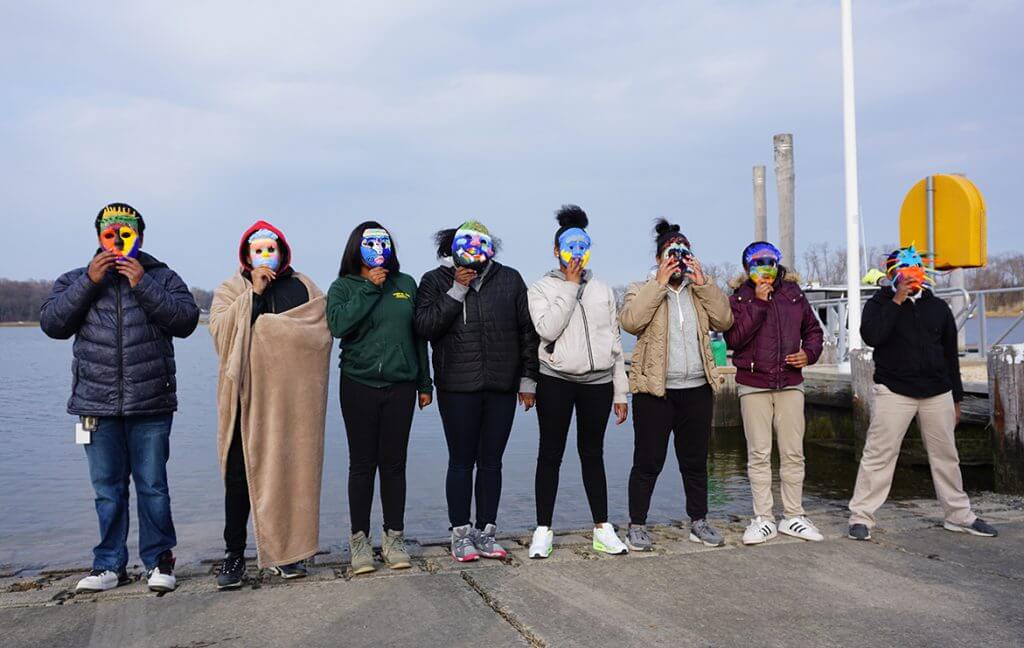
A project created by Monmouth University Assistant Professor of Art and Design Kimberly Callas is providing at-risk youth an opportunity to learn about the coastal environment and science through an artistic lens.
Through Discovering the Ecological Self, middle school students from the Red Bank-based Aslan Youth Ministries take field visits and classroom lessons focused on nature-based topics, explore them from philosophical and cultural perspectives, and create works of art inspired by them.
Marine and Environmental Biology and Policy senior Rebecca Klee and junior Taylor Donovan have volunteered their time to guide the science teachings, with support from Assistant Biology Professor Dr. Pedram Daneshgar. Students from Callas’ AR 218 Sculpture II course have helped mentor the youths on their artwork.
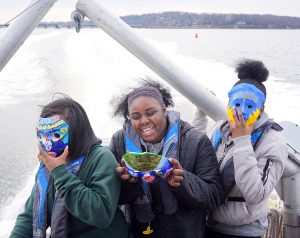 Callas said the project is an example of a developing field in the arts called “social practice,” or socially engaged art, which focuses on collaboration with communities. She said the approach is all the more valuable in an era when young people’s time is increasingly occupied by indoor activities like video games and school work.
Callas said the project is an example of a developing field in the arts called “social practice,” or socially engaged art, which focuses on collaboration with communities. She said the approach is all the more valuable in an era when young people’s time is increasingly occupied by indoor activities like video games and school work.
“Social practice is when artists work in communities around social issues – in this case sustainability and addressing environmental issues,” Callas said. “The focus of my project is to get people more in touch with nature.”
UCI staff recently took the students for a boat tour of the Two Rivers area and Sandy Hook Bay. While one group was on the water, another observed plants and the shoreline environment at the Monmouth Marine and Environmental Field Station site in Rumson. Many wore masks they created with designs inspired by previous nature lessons.
Callas and Daneshgar said they would like to continue the project with additional organizations in the future, incorporating even more hands-on activities in the field. This semester’s work was supported with grant funding from the UCI’s Marine Science and Policy Initiative.
Report Assesses Mid-Atlantic Coast’s Economic Vulnerability to Climate Change
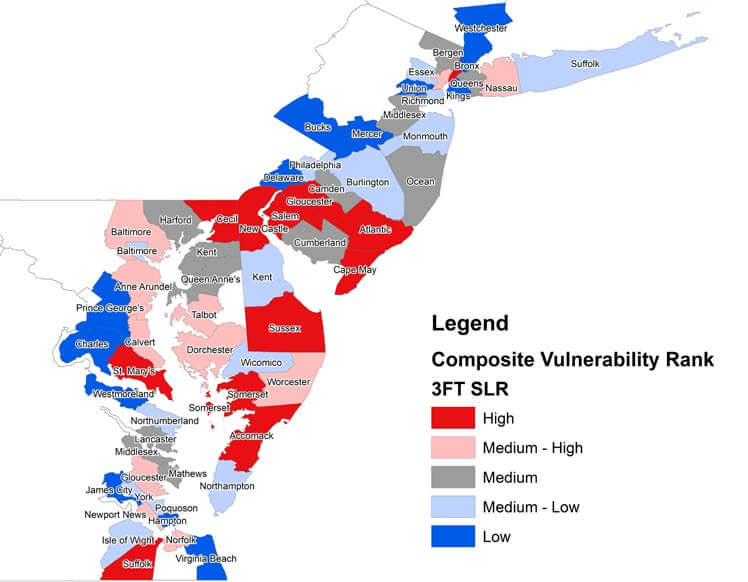
The Mid-Atlantic Regional Council on the Ocean (MARCO) has released a first-of-its-kind report at the Mid-Atlantic scale that examines the vulnerabilities of several critical economic sectors to climate change. The report quantifies the potential impacts of threats like sea level rise, rising ocean temperatures and changes in the ocean’s chemistry to communities and businesses in 63 counties and independent cities along the coast from New York to Virginia.
The report, “Climate Change Vulnerabilities in the Coastal Mid-Atlantic Region,” was prepared in collaboration with the UCI as part of the Planning for a Changing Ocean project, which aimed to better understand how a changing climate impacts our ocean and the Mid-Atlantic’s diverse marine ecosystems, coastal communities and economies. The project examined the implications for resilience of current trends, including increased acidification of coastal and ocean waters, the availability of offshore sand resources and shifting marine life habitats.
Read a news release summarizing the study.
Register Now for Webinar on Beneficial Reuse of Sand Resources
The UCI and Mid-Atlantic Regional Council on the Ocean (MARCO) will host a webinar on May 30 that centers on how federal and state agencies can work together to ensure the best use of the Mid-Atlantic’s limited offshore and nearshore sand resources. The webinar will focus on agency roles and responsibilities, best practices, and opportunities and impediments to beneficial reuse of sand and sediment in the region. Click here for additional details.
NY Bight Wind Energy Meeting Held at Monmouth U.
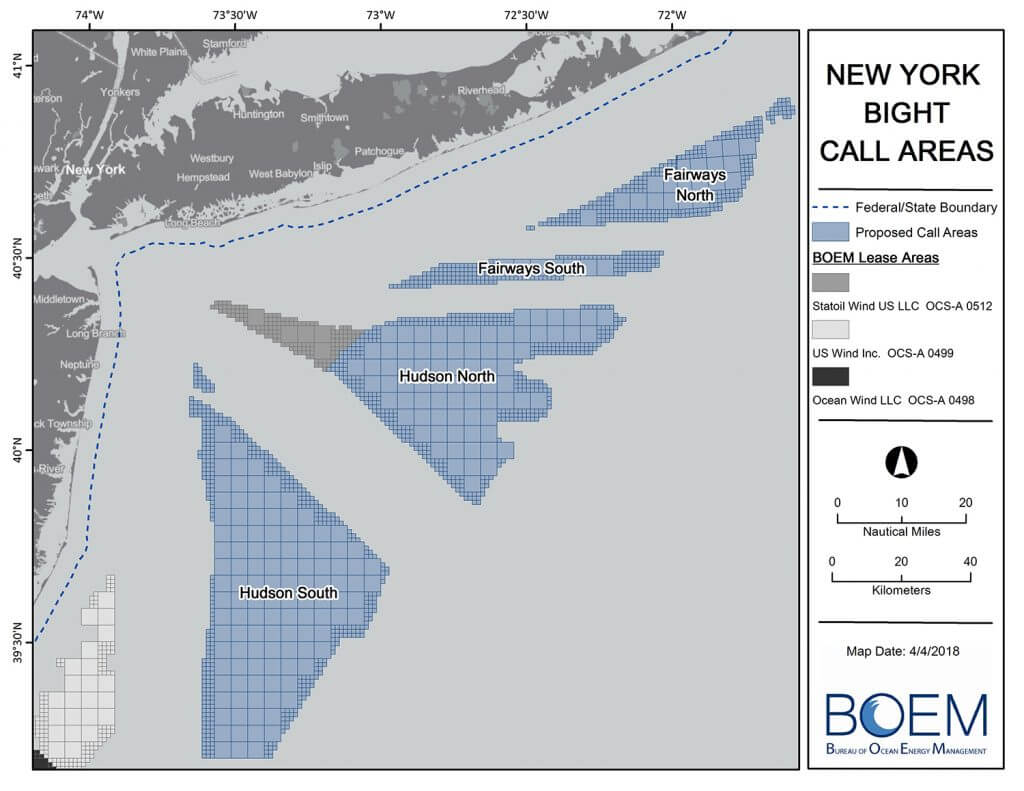
The federal Bureau of Offshore Energy Management (BOEM) will accept public comments through May 29 concerning a cluster of potential offshore wind areas located off the coasts of New Jersey and New York.
BOEM recently published a Call for Information and Nominations from companies interested in obtaining commercial wind energy leases within four areas within the New York Bight that cover roughly 2,000 square nautical miles along the continental shelf. The agency is seeking public input on any conditions or information that should be considered as it determines whether or not the areas, or specific portions of them, would be suitable for wind farms.
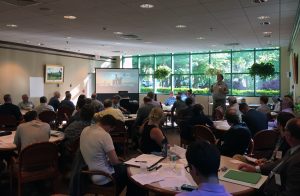 BOEM held a meeting at Monmouth University May 8 to discuss the matter with representatives of New Jersey fisheries. The session sought to gather information on important fishing areas and traditional transit routes, inform attendees on the process/next steps, and promote a dialogue on other offshore wind and marine mineral activities.
BOEM held a meeting at Monmouth University May 8 to discuss the matter with representatives of New Jersey fisheries. The session sought to gather information on important fishing areas and traditional transit routes, inform attendees on the process/next steps, and promote a dialogue on other offshore wind and marine mineral activities.
UCI staff participated in the meeting as well as one held the following day in Newark which assembled officials from both states, several federal agencies and interested stakeholder groups to share their views and information about offshore wind in the New York Bight. Those interested in learning more can visit BOEM online.
An interactive map of the NY Bight Call Areas can be found on the Mid-Atlantic Ocean Data Portal, which is maintained by a team that includes the UCI. Portal users can explore how the zones overlap with thousands of other map layers showing fishing activities, shipping concentrations, marine bird migration routes and more, and include those maps with their comments to BOEM. Those who have questions or need assistance with using the Portal may contact the UCI’s Karl Vilacoba at kvilacob@monmouth.edu.
The UCI will continue to monitor the NY Bight Call process and share information as it becomes available.
EarthShare NJ to Honor UCI for Environmental Education Work
Join us June 8 – recognized around the globe as World Oceans Day – at Bell Works in Holmdel as the UCI is honored with EarthShare NJ’s Excellence in Environmental Education Award. Now in its 12th year, the EarthShare Celebrates New Jersey awards dinner recognizes remarkable organizations that have made a difference for the environment.
The public is invited to celebrate the UCI and this year’s Environmental Partnership Award recipient, the New Jersey Corporate Wetlands Restoration Partnership, as a sponsor or guest for the evening of live jazz and gift auctions featuring experiences throughout New Jersey. Click here for tickets or additional information.
Monmouth Magazine Infographic: Offshore Drilling in the Mid-Atlantic
Pick up a copy of the Spring 2018 issue of Monmouth magazine to view a two-page infographic featuring the UCI and Monmouth University Polling Institute’s two recent surveys of Mid-Atlantic residents on ocean issues. The infographic focuses on respondents’ views on offshore drilling, which became a front-burner issue this year when the Trump Administration announced they would consider opening the East Coast to oil and gas exploration. View a PDF version of the infographic as it appeared in the print version or view a digital rendition on the magazine’s website.
Read About Gaffney-Led Reports on Oil Trains, Gulf Loop Current
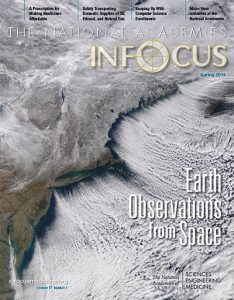 The spring issue of The National Academies In Focus contains two articles highlighting reports chaired by UCI Ocean Policy Fellow and Monmouth University President Emeritus Paul G. Gaffney II. The first, found on page 16, examines the safety ramifications of a recent boom in transporting crude oil and other flammable fuels via America’s freight rail system vs. the alternative modes of pipelines and waterways. A second article on page 19 outlines the findings of a report about importance of widening research and improving prediction capacity of the Gulf of Mexico Loop Current System. Download a PDF copy of the issue.
The spring issue of The National Academies In Focus contains two articles highlighting reports chaired by UCI Ocean Policy Fellow and Monmouth University President Emeritus Paul G. Gaffney II. The first, found on page 16, examines the safety ramifications of a recent boom in transporting crude oil and other flammable fuels via America’s freight rail system vs. the alternative modes of pipelines and waterways. A second article on page 19 outlines the findings of a report about importance of widening research and improving prediction capacity of the Gulf of Mexico Loop Current System. Download a PDF copy of the issue.
Tool Can Predict Streamflow in Local Watersheds

Monmouth University GIS Program Director and Cartographer Geoff Fouad has published a study in the Journal of Hydrology: Regional Studies that introduces a tool that can predict water flows for rivers throughout the U.S. The tool is a product of a UCI-supported research that evaluated how nearly 40 variables can impact streamflow.
The study discovered that only three variables were essential for predicting streamflow: water entering a watershed (precipitation), water leaving a watershed through the atmosphere (potential evapotranspiration), and water discharging through the ground (baseflow). The tool can use these variables to generate streamflow predictions for local watersheds. Read the study and learn more about the tool.
Student Recognized for Research on Diet of Sturgeon
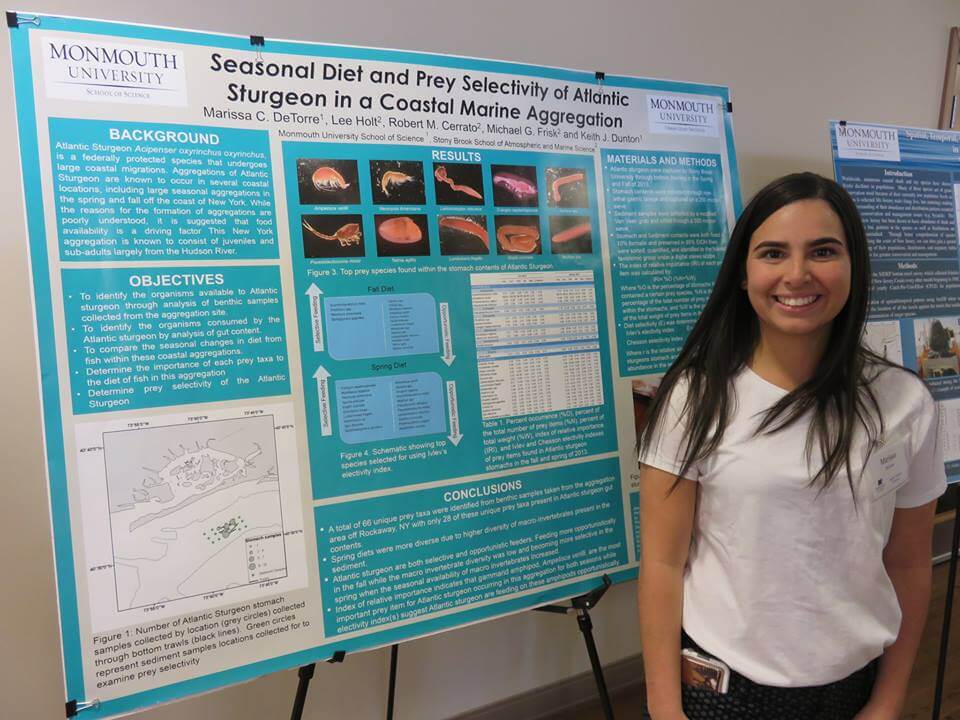
Congratulations to Marine and Environmental Biology and Policy (MEBP) student Marissa DeTorre on being named a co-recipient of the Jane Freed Award, given by the Monmouth University Honors School for the most outstanding theses of the year. Marissa was also recognized with a Dean’s Award for Excellence for having the top MEBP poster at the School of Science’s Student Research Conference. The UCI is proud to have supported Marissa’s research on the diet and prey of the endangered Atlantic sturgeon through the Heidi Lynn Sculthorpe Summer Research Program.

